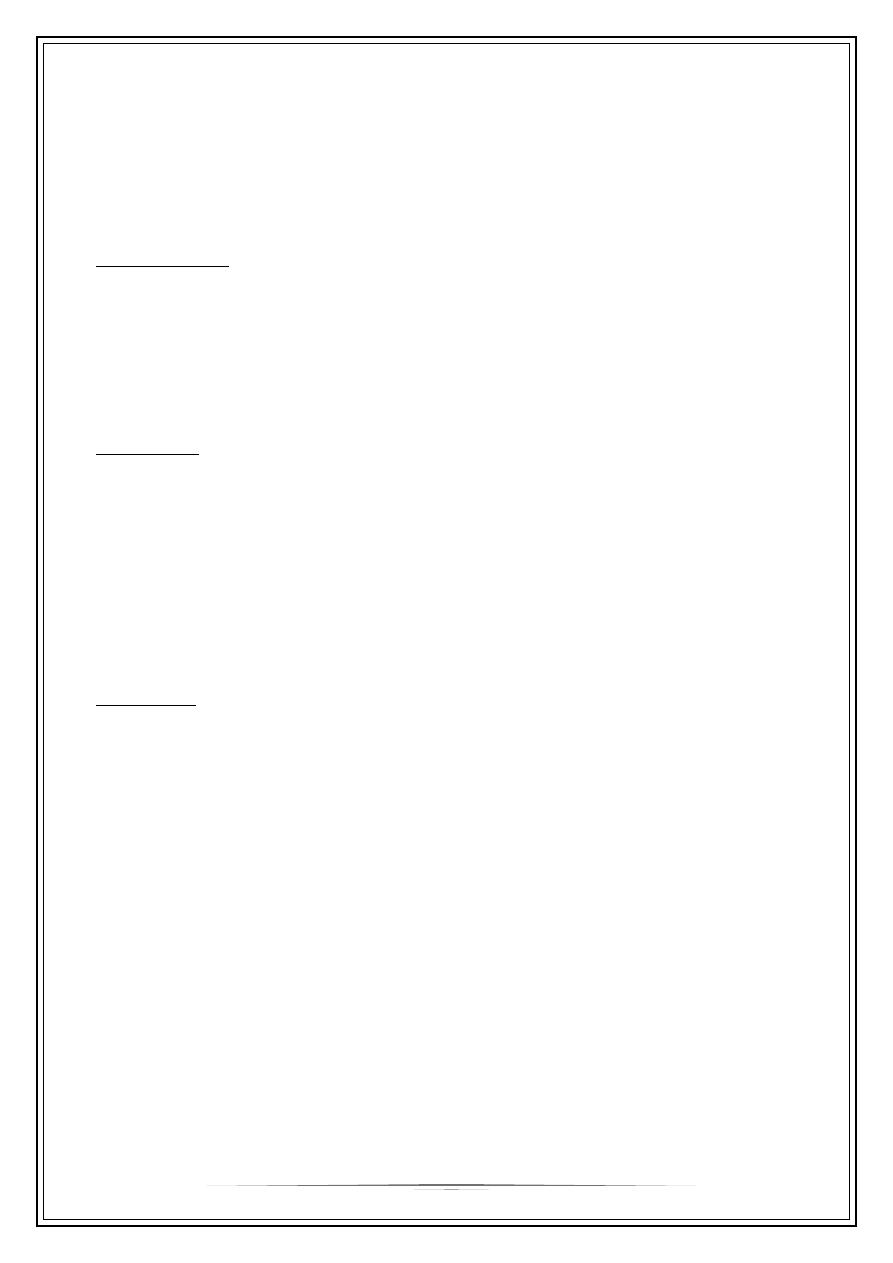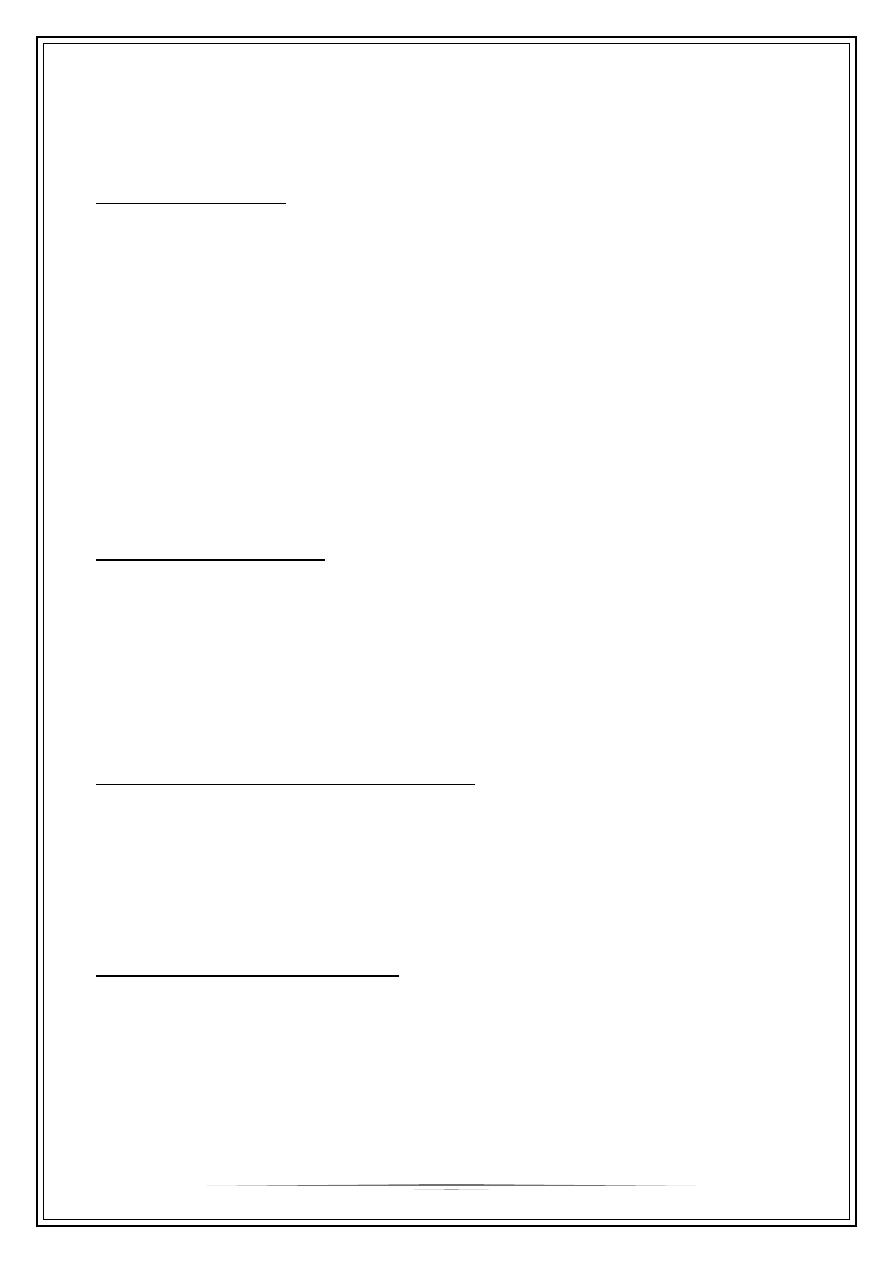
Fifth Stage
Internal Medicine
Dr. Dhyiaa – Lecture 3
1
Glomerular Diseases
Part 1
Pathological features:
Diagnosis of glomerular diseases based on pathological features
1. Focal:
some but not all the glomeruli contain the lesion.
2. Diffuse:
global, mo9st, more than 75% of the glomeruli contain the lesion.
3. Segmental:
only part of the glomerulus is affected ((most of the focal lesions are
also segmental))
4. Proliferation:
Increase in the cell number with or without inflammatory cell
infiltration.
5. Membrane alteration:
capillary wall thickening or basement membrane alteration.
Presentations:
1. Protienuria:
Which is due to either
:
a. loss of the net negative charge on the capillary wall
(( selective protienuria ))
b. structural defect in the filtration barrier
(( non selective protienuria))
* when protienuria exceed 3.5 gm/day it is called
Nephrotic range protienuria
2. Hematuria:
in form of dysmorphic RBC and RBC casts.
3. Salt retention:
may expressed as oedema, volume overload, hypertension &
congestive heart failure.
4. Renal impairment:
ranging from minimal to severe impairment requiring dialysis.
SYNDROMES
GLOMERULAR
NEPHRETIC SYNDROME:
This syndrome is characterized by the abrupt onset (( days )) of haematuria with
RBC cast and protienuria less than 3.5 gm/day, temporally ass0ciated with
hypertension and renal impairment.

2
1. POSTSTREPTOCOCCAL GN:
It is a complication for certain strains of group A, β-hemolytic streptococci. Usually
with 5 – 20 days latent period, typically in children 3 – 12 years but it can occur in
adult. The patient presented with malaise, cola colored urine, haematuria, mild
hypertension, periorbital oedema, protienuria and renal impairment (( variable )).
Investigations:
1. Haematuria, RBC cast
2. Protienuria < 3.5 gm/day.
3. High ASO titer
4. Low serum complement
Treatment:
1. Non specific treatment
2. Salt restriction
3. Diuretics
4. Antihypertensive
5. Antibiotics, if culture positive for streptococci
6. Dialysis in cases of severe acute renal failure
Prognosis:
•
Complete recovery in 90%
•
Rarely progress to CRF mainly older age and oliguria > 7 days.
2. Non Streptococcal postinfectious GN:
•
Bacterial: Staphylococci, Pneumococci
•
Viral : Mumps, Coxsackie, Varicella
•
Protozoal: Toxoplasmosis
•
Usually same presentation to PSGN with low serum complement and evidence of
the underlying infection itself.
3. GN associated with infective endocarditis:
Commonly with chronic right side cardiac involvement, mild presentation, low
serum complement, Treated by treatment of the underlying cause.

3
4. SHUNT NEPHERITIS : Low serum complement
5. GN associated with visceral abscesses:
Mostly with pulmonary abscesses, normal complement, successful antibiotic
therapy result in recovery in renal function only in about 50% of patients.
RAPIDLY PROGRESSIVE GN
It characterized by nephronal haematuria with renal failure developing over weeks
to months and diffuse glomerular crescent formation on renal biopsy
1. Anti – Glomerular Basement membrane GN: eg. GOOD PASTURE’S SYNDROME:
It is a disorder that affect young male more than female. Usually presented with
hemoptysis, dyspnea, pulmonary hemorrhage and normal serum C3 level.
Treatment with high dose steroid and plasma exchange.
2.IMMUNE COMPLEX RPGN:
•
Almost always associated with underlying disease
•
The prognosis of the underlying condition decline in the presence of immune
complex RPGN.
3. NON IMMUNE MEDIATED RPGN:
•
It is seen in association with one of systemic vasculitis such as polyarteritis nodosa
or as an idiopathic form.
•
Treatment by; Steroid, Plasma exchange & Cytotoxic.
ASYMPTOMATIC URINARY ABNORMALITIES:
1. Isolated protienuria
•
Asymptomatic, less than 2gm/ day.
•
Postural protienuria
•
May represent early manifestation of more serious glomerular disease eg. Diabetic
nephropathy
•
May accompany other conditions eg. Febrile illness, congestive heart failure or
infectious diseases.

4
2. Isolated haematuria with or without protienuria:
It could be represent early manifestation of another glomerular disease such as
SLE but it may be the primary presentation of:
A. Ig A Nephropathy:
•
It is the most common primary glomerular disease
•
The typical presentation is gross haematuria following viral infection
•
Male > female
•
Age 15 – 35 years
•
Mild protienuria
•
Normal serum complement
•
Progressive renal impairment may developed after 20 years.
•
No effective therapy
•
Poor prognostic indicators include: hypertension & heavy protienuria.
B. ALPORT’S SYNDROME:
•
Hereditary disease, X – linked.
•
Presented in childhood with recurrent gross haematuria, mild protienuria and
sensorineural deafness.
•
Often develop renal failure by the age of 30 years.
•
No effective treatment.
C. THIN BASEMENT MEMBRANE DISEASE:
•
It affect both genders
•
Usually presented with haematuria without protienuria in asymptomatic young
adult.
•
Excellent prognosis.
D. Benign Recurrent Haematuria:
•
It is diagnosed by asymptomatic haematuria when other possibilities are excluded.
•
May presented with gross haematuria associated with febrile illness, exercise or
immunization.
•
Renal biopsy is normal in most of them.
•
The overall prognosis is excellent.
To be continued,,,
